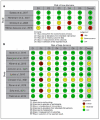GRAFTS FOR ANTERIOR CRUCIATE LIGAMENT RECONSTRUCTION: SYSTEMATIC REVIEW AND META-ANALYSIS
- PMID: 36561474
- PMCID: PMC9757723
- DOI: 10.1590/1413-785220223006e256048
GRAFTS FOR ANTERIOR CRUCIATE LIGAMENT RECONSTRUCTION: SYSTEMATIC REVIEW AND META-ANALYSIS
Abstract
Objective: This study proposes to systematically review the literature and compare data on (1) function, (2) pain, (3) return to sport, and (4) complications after anterior cruciate ligament (ACL) reconstruction with quadriceps tendon autograft (QT) and hamstring tendon autograft (HT).
Methods: In June 2021, a systematic review of the EMBASE, MEDLINE/PubMed, Cochrane Central Register of Controlled Trials, and LILACS databases was performed, based on PRISMA guidelines. The search strategy included the keywords: "Previous Cruciate Ligament Reconstruction," "ACL reconstruction," "quadriceps tendon autograft," "quadriceps graft," "Hamstring-Tendon Autografts." Meta-analyses were performed using Review Manager software (RevMan Web).
Results: There were no significant differences between the two groups regarding function according to Lysholm score (MD 3.01; CI-0.30, 6.33, p = 0.08), the presence of pain (RR 0.89; CI-0.57, 1.39, p = 0.60), and re-rupture (RR 0.60; IC-0.19, 1.88, p = 0.38).
Conclusion: QT and HT autografts show comparatively good results in ACL reconstruction without significant differences regarding function, pain, and rupture after surgical intervention. Level of Evidence II, Systematic Review of Level II Studies.
Objetivo: Revisar sistematicamente a literatura e comparar dados sobre função, dor, retorno ao esporte e complicação após a reconstrução de ligamento cruzado anterior (LCA) com autoenxerto do tendão do quadríceps (TQ) e autoenxerto do tendão dos músculos isquiotibiais (TF).
Métodos: Em junho de 2021, foi realizada revisão sistemática das bases de dados EMBASE, MEDLINE/PubMed, Cochrane Central Register of Controlled Trials e LILACS, baseada nas diretrizes do Preferred Reporting Items for Systematic Reviews and Meta-Analyses (PRISMA). A estratégia de pesquisa incluiu as palavras-chave: “Anterior Cruciate Ligament Reconstruction”, “ACL reconstruction”, “quadriceps tendon autograft”, “quadriceps graft” e “Hamstring-Tendon Autografts”. As metanálises foram realizadas usando o software Review Manager (RevMan Web).
Resultados: Não houve diferenças significativas entre os dois grupos com relação à função pelo escore de Lysholm (MD 3,01; IC-0,30, 6,33, p = 0,08), presença de dor (RR 0,89; IC-0,57, 1,39, p = 0,60) e re-ruptura (RR 0,60; IC-0,19, 1,88, p = 0,38).
Conclusão: Os autoenxertos de TQ e TF apresentam resultados comparativamente bons na reconstrução do LCA sem diferenças significativas com relação à função, dor e ruptura após a intervenção cirúrgica. Nível de Evidência II, Revisão Sistemática de Estudos de Nível II.
Keywords: Anterior Cruciate Ligament; Hamstring Tendons; Quadriceps Muscle; Tendons.
Conflict of interest statement
All authors declare no potential conflict of interest related to this article.
Figures





References
-
- Prentice HA, Lind M, Mouton C, Persson A, Magnusson H, Gabr A. Patient demographic and surgical characteristics in anterior cruciate ligament reconstruction a description of registries from six countries. Br J Sports Med. 2018;52(11):716–722. - PubMed
-
- Mehran N, Damodar D, Shu Yang J. Quadriceps tendon autograft in anterior cruciate ligament reconstruction. J Am Acad Orthop Surg. 2020;28(2):45–52. - PubMed
Publication types
LinkOut - more resources
Full Text Sources
